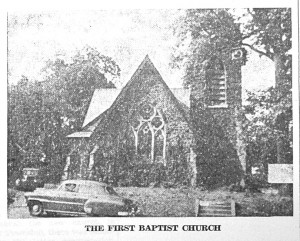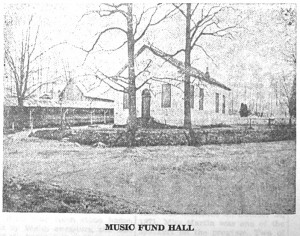The minutes of the first few years of the existence of the Radnor Baptist Church make entertaining reading, not only as the history of the founding of one of Wayne’s early places of worship, but also in the insight they give into what might in these days be considered the private lives of the members of the congregation. In the 1840’s there was seemingly little privacy in the lives of any one connected with the church.
At a business meeting held on January 20, 1848, one of the matters under consideration was “a charge preferred against Sister T. for accusing Brother M. of swearing and telling lies”. Later Brother L. “was appointed to visit Brother M. to investigate these charges.” Then the committee in charge of looking into the case reported that they have been informed that “the charge of swearing was true, but did not know that lying was included.” Then Sister J. and Sister B. testified that “they too had heard Brother M. swearing.” By May a committee of five was appointed to meet Brother M. and his accusers “at the school room on Saturday evening at 6 o’clock.” It would be interesting to know the final outcome of Sister T.’s accusation. But by June the case against Brother M. was “indefinitely postponed” when “accusation failed to be made out”, even though Brother M. “was called up through the committee.” In all the matter of Brother M. was before the church some six months.
Then there was the case of Brother B., when information was laid before the Church that “he had been drinking intoxicating liquor” and “a committee was appointed to visit him and inquire into the facts”. This committee reported that the Brother in question had acknowledged that he “had drunk intoxicating liquor at the time reported, but took it as a medicine. Thinks he ought to be allowed to drink when in need of it, and was deceived with respect to our principle.”
That committee was dismissed after making its report and another was named “to labor with Brother B. and endeavor to bring him to see his error.” This second committee reported that he Brother in question “drinks as a medicine.” They requested him to “attend Church Meeting, and he thought he would.” Whereupon the second committee was discharged. The minutes of church meetings for some months after that report that “the case was laid over.” But, finally “Brother B. being present, made a statement of his views and feelings to the church, and on motion was restored.” Whether he was permitted to continue “to drink as a medicine” is not quite clear in the minutes, however.
Committees were continuously being appointed to inquire into the cases of those who had “absented themselves from the house of worship.” In one such case when two sisters “were waited on”, it was found that one “had united with the Methodist.” The other “had not, though she worshiped with them, and neglected her place in her own church. She promised to appear if she could possibly leave home.” Brother E. stated that he had not “felt fit to come to the communion table.” However, in absenting himself “he had no hard feelings against any one member of the church . . . he had been led to see the wrongfulness of his conduct.”
Apparently the committees in the end always obtained the answers they had been appointed to seek out!
Under “new business” of the Church meeting of June 19, 1845, there is one paragraph which states “whereas improvement of singing in our church is desirable, therefore, Resolved, that as many of those who sing as may be disposed to do so are hereby permitted to sit together for that purpose.” The, apparently as an afterthought comes the concluding sentence: “The foregoing is not intended to prevent any from singing.”
When one Brother who had been connected with the Church from its earliest beginnings asked for his letter of dismissal, another Brother was appointed to call upon him for his reasons for such a request. The main grievance, it appeared, was “that he had been displaced form leading the singing rather uncourteously.” Whereupon “the church passed the following Preamble and Resolution: Whereas Brother A. feels that the church has acted disrespectfully towards him in appointing a singer in his place without consulting him, therefore resolved that this Church acknowledges its error and hereby instructs the Clerk to write to Brother A. the acknowledgement and ask his forgiveness.”
Brother A. said he did “forgive the offense, but still requested his letter.” This the Church did not see fit to grant, “deeming his reasons for leaving as insufficient.” However, Brother A. persisted to the point of finally obtaining his letter.
Personal difficulties were not confined to members of the Church, however, After serving more than three years as its minister, Brother Hobart tendered his resignation on the grounds of “diversity in the views entertained by some members of the Church and myself.” He also stated that “duty requires that I should provide for the wants of my family and pay my honest debts.” And he does not see that he can do this “under existing arrangements.” Apparently even as long ago as the 1840’s a yearly salary of $350 was not enough to support a family! For although Brother Hobart had asked for an increase to $400 the second year of his ministry, he had apparently never received more than $350. And even this amount had been hard to obtain by solicitation from members of the Church, as various notes in the minutes bear witness. The situation came to such a pass in the matter of arrears in the minister’s salary that those who could not show good reason for failing to meet their pledges could be suspended from membership.
After several ministers had declined calls to the Radnor Baptist Church the committee reported a satisfactory interview with Brother J. Perry Hale, whose “views coincide with the church in essential matters. he would be willing to labor with the church if he feels duty points that way. And thinks $400 would be necessary to meet his wants.”
Brother Hale received an unanimous call to the church. However, his pastorate lasted a scant two years. In December, 1846, he tendered his resignation, to take effect the following April. His reasons were given in the simple statement “whereas several of the Brethren think that it would be better for both me and the church were I to resign the charge of the church, I hereby tender my resignation.”
By April Elder Thomas Goodwin was called to the pastoral care of the Church until the ensuing April 1, 1848. The committee who were responsible for calling him “promised in behalf of the Church to raise for his support $350, which terms were by him accepted.”
Apparently the early years of the Radnor Church were difficult ones for all concerned.
(To be continued)


